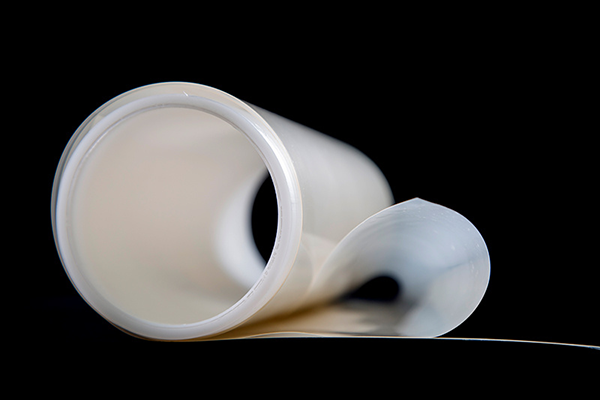Product Introduction of Polymer Proton Exchange Membrane:
By incorporating ePTFE (expanded polytetrafluoroethylene) microporous reinforced material into the traditional proton exchange membrane, we achieve high strength, excellent conductivity, and low ion permeability. ProtoneX's PEM for hydrogen fuel cell membranes has been demonstrated in both laboratory settings and the market to be comparable to similar products from Gore.
Product Advantages of Polymer Solid Electrolyte Membrane:
The Polymer electrolyte membrane material we produce has excellent selectivity and can effectively separate and remove specific ions in water. The membrane material used in the Polymer proton exchange membrane we produce has good water permeability, ensuring the flow rate and treatment efficiency during the water treatment process. The Polymer solid electrolyte membrane we produce can work stably at higher temperatures and adapt to different water treatment process conditions.

Thickness and Basis Weight Properties of Polymer electrolyte membrane material:
| Membrane Type | Thickness(microns)(um) | Weight(g/m²) |
| PXHY-25-T01 | 25 | 50 |
Physical and Other Properties of Polymer electrolyte membrane material:
| Physical and Other Properties | Typical Value | Test Method |
| Tensile Test (23°C,50%RH) | / | |
| Tensile Strength(MPa) | ≥28/28 | GB/T 20042.3-2022 |
| Tensile Modulu(MPa) | ≥400/400 | GB/T 20042.3-2022 |
| Elongation at break(%) | >100/120 | GB/T 20042.3-2022 |
| Specific Gravity | 1.97 | — |
| Other Properties | Index Parameters | Test Method |
| Conductivity(S/cm) | ≥0.100 | GB/T 20042.3-2022 |
| Hydrogen Crossover [cm3·cm/(cm2·s·0.1MPa)] | / | GB/T 20042.3-2022 |
| Hydrogen Crossover Current (mA/cm2) | / |
Hydrolytic Properties of Polymer solid electrolyte membrane:
| Hydrolytic Properties | Typical Value | Test Method |
| Water Content(%) | 5.0±3.0 | GB/T 20042.3-2022 |
| Water Uptake(%) | 50.0±5.0 | GB/T 20042.3-2022 |
| Thickness Swelling Rate at 23°C, 50% RH (% increase) | ||
| 23℃ soaked from 50% RH | ≤10 | GB/T 20042.3-2022 |
| 100 ℃ soked from 50% RH | ≤30 | GB/T 20042.3-2022 |
| Linear Expansion at 23℃, 50% RH (% increase) | ||
| / | ||
| 23℃ soaked from 50% RH | ≤4 | GB/T 20042.3-2022 |
| 100℃ soaked from 50% RH | ≤20 | GB/T 20042.3-2022 |
Packaging of Polymer solid electrolyte membrane:
Moisture-proof packaging: Place desiccant in the packaging bag to absorb residual moisture.
Protective materials: Use hard materials (such as plastic or metal plates) as support to prevent the film from bending or folding during transportation.
Laminated packaging: If multiple films need to be stacked, make sure there is an isolation layer between each film to prevent mutual adhesion and friction.
Outer packaging: Use sturdy cartons or wooden boxes as outer packaging to provide additional protection.
Notes of Polymer proton exchange membrane:
Mechanical stress: Prevent the membrane from mechanical stress or vibration to avoid rupture or deformation of the membrane.
Current density: During operation, control the current density within the design range to avoid excessive current density causing local overheating and aging of the membrane.
Storage conditions: Unused proton exchange membranes should be stored in a dry, light-proof and sealed environment to avoid the effects of high temperature and humidity on the membrane.